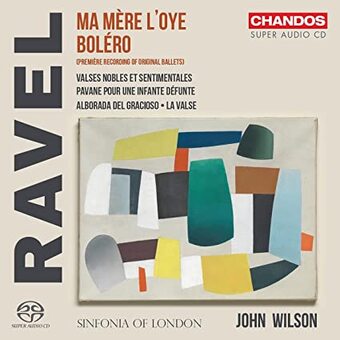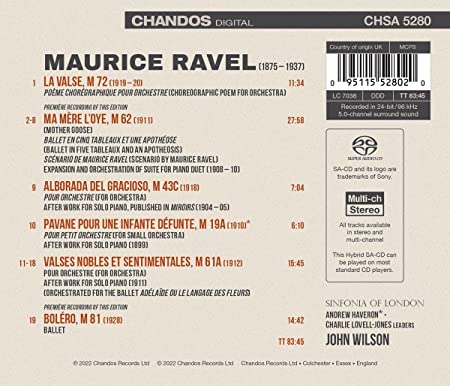Another enjoyable concert from John Wilson, but I have some issues with Chandos on this one3/31/2022 Chandos is on a roll with John Wilson and his Sinfonia of London. And for good reason. This current release is no exception, offering a whopping 83+ minutes (!!) of Ravel's greatest hits, gloriously played by the fabulous Sinfonia of London.
But I've got some issues with Chandos on this one. So let me get to the main one right upfront so we can move on to the music. On the back insert, in small print, Chandos claims that this Ma Mere L'Oye (Mother Goose) and Bolero are each a "Premier Recording of This Edition". Oh really? And what edition is that? Before listening to a single note, I scoured the extensive booklet looking for details about these potentially exciting, newfound editions that, apparently, Mr. Wilson alone is privy to. And other than a simple listing on the back page of the publication dates of the scores - ummm......Crickets. There is not a word from the booklet writer about these "new editions". Not one single mention of any kind. Of Bolero, there is merely a brief comment: "John Wilson has meticulously restored many details of the score which have become lost...". So it's not really a "new edition", but rather Wilson simply follows the printed score? And if these details are contained within the published score, were they ever really "lost"? Listening first to Mother Goose, I hear absolutely nothing new, different or unusual about it. It sounds exactly like it always does, with regard to content, orchestration, dynamics, tempos, etc. As to Bolero, I was delighted to hear Mr. Wilson does indeed follow the score a little more closely than most conductors (well, for the most part). First, he encourages his two saxophone players to actually execute the lip slurs, as printed in the score, which almost every conductor on earth inexplicably ignores. Not only is it interesting to hear (and adds marvelously to the bolero flavor), it makes the trombone's glissandos, which come a few bars later, much more musically appropriate. They're no longer just raspberries by a showoff trombonist, but rather now completely in line with the essence of the music and intentions of the composer, being played in the same manner as the saxophones do before it. I also detected a brighter, more ringing sound to the first saxophone solo and suspect that Wilson's soprano sax player actually found and plays the rare Sopranino sax (in F), as dictated in the score. Also, I thought the English Horn solo, earlier in the piece, sounded a little sweeter and more singing than usual, with exquisite vibrato. I was actually surprised to discover, looking in my score, that Ravel in fact writes that solo for the oboe d'amore. And I do believe that's what is played on this recording. That sums up the entirety of what I heard as being notable, or somewhat different from the norm. And I congratulate Mr. Wilson for taking the time and trouble to observe those aspects of the printed score (which, by the way, are all there in my 1988 pocket score). But still, I come back to Chandos and ask: Does that make this a "New Edition"? Granted most conductors do not bother with these minor details - after all, it's Bolero, not to be taken all that seriously, and typically programmed merely to get people to buy tickets and/or CDs. But is Mr. Wilson really the first one to observe them? I have heard the saxophone lip slurs before (although not very often), and I'm pretty sure I've heard the oboe d'amore solo before. Perhaps maybe not the Sopranino sax. However, since when does following the printed score make it a "premier recording of a new edition"? I am perplexed by this. And speaking of faithfulness to the score, Wilson (along with virtually every conductor since Ormandy) still manages to bury the fascinating arpeggiated pizzicatos in the 2nd violins and violas at Figure 9. It's all but inaudible, as usual. That would have been a nice detail to bring out, which would have had many folks reaching for their scores to discover what it is. And the second snare drum called for at Figure 16 is hardly noticeable unless specifically listening for it. Otherwise, this is as uneventful a Bolero as one typically hears. The hypnotic tension is curiously missing and I didn't think the slow, building intensity of the crescendo is executed all that successfully. And like many before him, Wilson takes it too fast. Coming in at 14 and 1/2 minutes, it's one of the fastest on record. Ravel himself stated, "it is a piece lasting 17 minutes..." Only Riccardo Muti comes to mind as faithfully observing that specification in his 1982 Philadelphia recording for EMI, which clocks in at 17:09. All that being said, I am happy to report the rest of the music-making on this program is terrific. The concert opens a little carefully, with a rather ordinary La Valse, although the rollicking horn writing is a delight. I enjoyed Mother Goose more. While there's nothing "new" about this edition, I found Wilson's characteristic no-nonsense, bare-bones approach to suit this piece particularly well. There is no lingering, or caressing a phrase; there is no love bestowed upon it whatsoever. It's just notes on the page for Wilson to get through. And this group of fabulous musicians does all the rest. It's as straightforward as can be, which actually allows Ravel's inspiration to shine through unadulterated. There is an attractive simplicity to it which, for me, works handsomely. Time to be alert for Alborada del Gracioso, which Wilson turns into a true showpiece that only an orchestra can deliver. No pianist could ever play all the repeated triplets or the dramatic scalic flourishes at this speed. But with this brilliant orchestra at hand (and in a rare display of unbuttoned exuberance), Wilson brings the gusto. And it is positively thrilling - full of flair and effortless bravura, along with the most songful, expressive bassoon solos in the central section. And with the Pavane following it, we come to my other complaint with the Chandos production. Neither the bassoon or horn soloists are named. And that is a pity, because both are quite wonderful. Finally, the highlight of the disc is most certainly Valses Nobles et Sentimentales. I was utterly astonished to hear Wilson - at last - take his time and lavish such love and sheer loveliness on this music. Tenderness abounds, along with exquisite phrasing, quite unlike anything I've encountered from John Wilson before. And this glorious string section delivers it for him big time, with positively silky string tone - lush and airy, yet transparent too. And despite my reservations with Bolero, it closes the concert with a bang. The Chandos house sound is, as ever, very good - although just a little stuffy and bass-rich this time compared to their very best. (They have yet to match the fantastic sound they achieved in the Korngold Symphony.) But it's a multi-channel SACD, which is always cause for celebration these days. And as noted above, the string sound is ravishing when it needs to be. In closing, I wish Chandos had not implied there was more on offer here than there actually is. Simply utilizing newly published scores, without any mention of any differences they may or may not possess, creates expectations left unfulfilled. But that aside, this is yet another enjoyable concert from John Wilson and company.
0 Comments
Leave a Reply. |
Proudly powered by Weebly


 RSS Feed
RSS Feed